Ahhhh, silk! It’s such a luxurious fiber, and so perfect for hand embroidery that it’s been used for centuries and centuries to embellish fabric, and ever considered the Queen of Embroidery Threads.
There are many different types of silk threads used in hand embroidery and other needlework. After all, silk embroidery threads differ in construction, in weight, in twists, even in types of fibers in their make-up.
Today, I want to chat with you about a silk thread that is a little mysterious and obscure (it’s certainly not the most commonly used silk thread in the world, that’s for sure!).
It’s also somewhat…well… odd.
The thread is silk chenille. Let’s look at it.
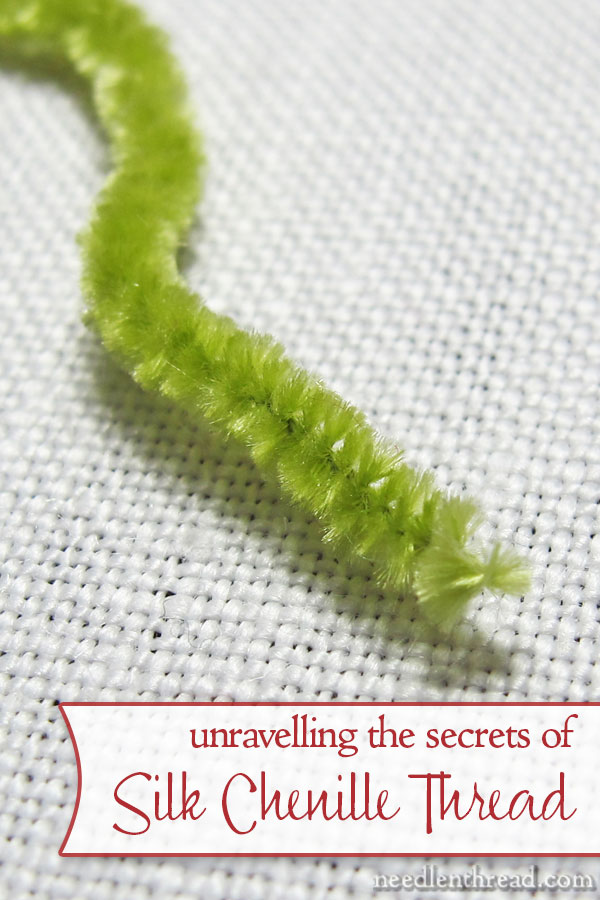
Silk chenille, as you can see, is a fuzzy embroidery thread, resembling a caterpillar, which is what “chenille” means in French.
Unlike other chenille threads made from cotton or acrylic and used for knitting and crochet, Au Ver a Soie’s silk chenille, made specifically for hand embroidery, is soft and velvety – like the smoothest of fine velvets – with no stiffness, no bristly-ness.
And while you might be tempted to liken it to the “magic worm” toys that we enjoyed as children – you know, the fuzzy worms with the googly eyes and the long snout, that you pull around on an invisible string – it’s not quite the same thing!
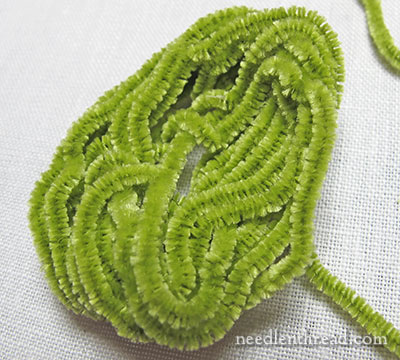
When you feel real silk chenille thread, you’ll wish it came in huge billows and pillows, so that you could burrow into it and live in it forever!
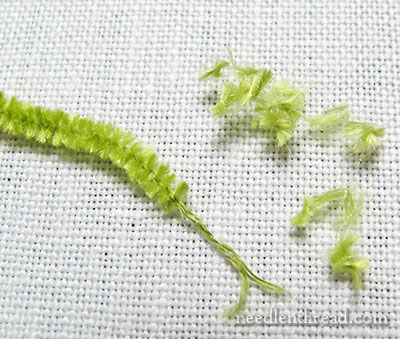
If you take a piece of silk chenille and strip the fuzzies off the end, you’ll find a three-ply twisted silk. The fuzzy part of the thread are similar to little tufts held on the thread inside the twists.
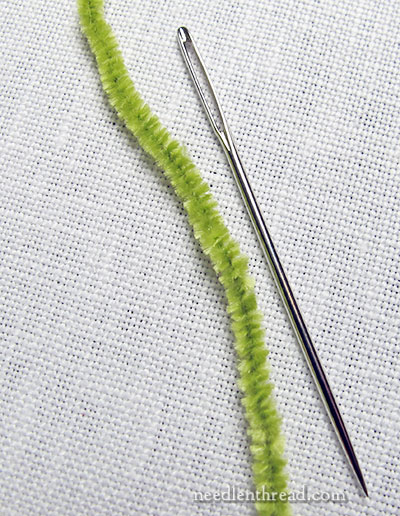
Silk chenille has its own type of needle named after it.
The chenille needle pictured above is a #18, which, if you’ve been using a smaller #9 or #10 crewel needle to embroider with one strand of floss, will feel decidedly like a railroad spike in your hands. It’s a big needle with a long eye and a sharp tip. In all respects except the sharp tip, it’s just like a tapestry needle.
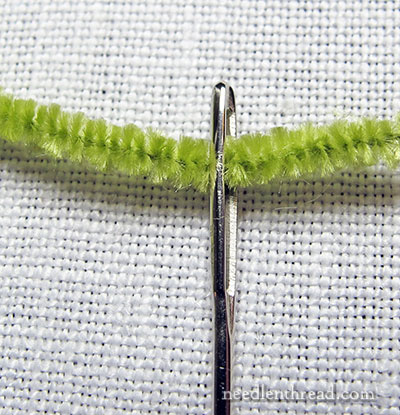
The large eye of the chenille needle is obviously necessary, if you want to thread the whole fuzzy girth of chenille into the needle.
The sharp tip and thick shaft are necessary for making the initial hole in the fabric and then opening it up to allow the thread to pass through.
Historic Use of Chenille Embroidery Thread
Silk chenille has been around for a long time! It’s been used in embroidery since at least the 17th century.
On the Heilbrunn Timeline of Art History on the Metropolitan Museum of Art’s website, you’ll find this 17th century embroidered box.
The box features chenille embroidery, although there are no close-up images of it on the website. Silk chenille was favored for working grass and moss on the ground, and adding clumps of foliage to trees on these exquisite works of needle art.
More recently, during the 18th century, silk chenille was favored for embellishing elaborate clothing and trim.
Over on Trouvais, a wonderful blog dedicated to French interiors, rough luxe, and flea market finds (especially of the 18th century), you can see a fantastic example of 18th century silk chenille embroidery on a silk waistcoat.
Also on Trouvais, you’ll find photos of another piece of gorgeous silk covered with swags of roses embroidered with silk chenille.
And even yet more recently – during the Victorian era – silk chenille was used on lavish crazy quilts, to embellish clothing and accessories (like handbags), and to embellish other items, like embroidered boxes, too.
Over on Plays with Needles, Susan Elliott’s fun and fabulous blog, you’ll find some up close, gorgeous photos of silk chenille elaborately embroidered all over velvet fabric adorning the outside of a decorative box that’s most certainly Victorian.
Today, silk chenille is used in hand embroidery still. It has enjoyed a recent revival of interest, thanks to the Cabinet of Curiosities classes on Thistle Threads, where 17th century embroidered caskets are explored in-depth in preparation for creating your own, and thanks to other classes and projects exploring 17th century embroidery.
Silk Chenille Today
One of my favorite contemporary uses of silk chenille came to me via a reader who only recently has begun exploring embroidery (and specifically crazy quilting) after a hiatus of 50 years since childhood.
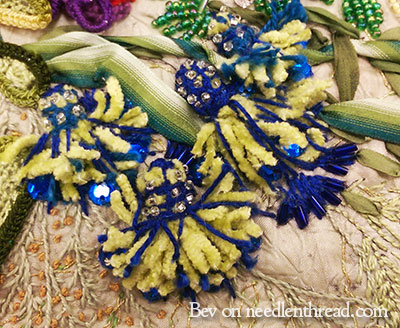
Bev used silk chenille to create luxurious bundles of beaded tassels on her first crazy quilt square, which I’ll share with you in detail further down the road. It’s a fantastic, exuberant piece encrusted with all kinds of embroidery techniques! The tassels are especially rich, thanks to the use of the chenille thread.
Today, silk chenille can be used in surface embroidery just as it was centuries ago, but it can also be updated and modernized, just like any historical thread. Once you understand the best ways to work with chenille, a world of stitching possibilities for this fuzzy thread will open up!
Working with Silk Chenille
In Part 2 coming up early next week, we’ll explore some tips on how to embroider with silk chenille thread.
Unlike floss, you can’t just launch into any embroidery on any fabric with any stitch, using silk chenille. It’s a somewhat persnickety thread, in a way, but we’ll wrestle it to the ground and explore how to stitch with it effectively.
We’ll also look at where you can find real silk chenille thread for your own embroidery projects.
Over to You!
Have you used silk chenille in your embroidery projects? What’s your favorite application of the thread? Do you have any tips to share?
Or is this a first introduction to silk chenille? If so, what would you like to know about it? What are your first impressions – like it? or no?







At first, I thought this was a picture of a pipe cleaner, which I don´t know for it´s intended purpose, but for using in arts and crafts.
I heard of chenille before, but I thought it was a very modern kind of thread (like, the last 30 years), so seeing this history I find it very interesting and I am curious what your next chapter on it will show. Is this a thread you came across by surprise, or while you were researching something specific?
Best of wishes, Marion
Hi, Marion – no, I’ve used it before, on a Christmas ornament. I think most people associate chenille with the 70’s – or at least, I know a lot of people who do – but yes, it’s been around for a long long time!
Oh, fun! I haven’t used it but I have a project coming up where I could enhance it by using some of this thread. Hmmmm….. possibilities.
Mary, you really outdid yourself with great links today! thanks so much. Since the membership of our chapter of EGA is within day trip distance of the Met, and we’ve been there now and then as a group, I was happy to remind them of the holdings there as well as other wonderful links you gave.
My husband uses some type of chenille for tying flies for fly fishing.
I would love to see more embroidery applications and tips on how to work with it.
Sally
Yes, I would love to see how you might use it, and also other readers as well. Sometimes seeing that sort of thing “gets the juices flowing” as to how “you” (meaning whoever is reading it) might use it in new and fun ways.
The silk chenille looks so intriguing and luxurious. Can’t wait to see Bev’s whole piece. I love things that are different. Mary, you bring us such interesting things!
Carol b
Good Morning, Mrs. Corbet! I hope you are having a gorgeous fall day in Kanas. I have heard of Silk Chenille before, I’m a Devine Design addict, but mostly as an upholstery fabric. Although, there might have been some embroidered drapes somewhere…
Have I used it before? I’m still on stranded cotton floss! LOL Would I use it? Possibly. I’m not usually into 3D embroidery, but if I had a project where I needed grass or seaweed I could see myself doing it.
To be totally honest I’m wondering if I can get this stuff in a yard that my mom can put on her loom! She’s a loom knitter and I want this stuff to make me a blanket!
Ooops… I meant YARN not yard!
Him Kristina – you can definitely get chenille yarns for crochet and knitting (they aren’t usually silk and are often a bit thicker than this), so I don’t see why you wouldn’t be able to find it for loom knitting.
We’re having a rainy, thundery, chilly day here in KS so far. I’m not complaining! Rain is good!
Rain is good! We’re not getting enough in my mountains. 🙁 Send us it when Kansas has drunk enough! I’ll be searching for Silk Chenille yarn, If I can burrow under a blanket of it, I won’t care if I sleep or not!
Can you use the silk chenille to do decorative embroidery stitches on wool?
Hi, Sher – we’ll be looking at uses next week. Do you mean wool, as in wool felt, or wool as in regular wool fabric?
Oh, soooo fascinating Mary. Thank you. I may just use this in some future pieces I have planned. I think it may have been a good choice for my fox’s tail had I known of it! I will be looking forward greatly for the next part on this thread.
Thank you, thank you for your wonderful blog. I do so look forward to it each and every day and miss it on those days you don’t send it out. It’s always a nice surprise to see and “extra” from Mary. 🙂 Have a wonderful weekend.
I love chenille thread to stitch fluffy french knot for the hearth of flower like in this edelweiss embroidery
http://2.bp.blogspot.com/-fbaQTaSOzOY/T6l5k54GYQI/AAAAAAAACqI/44r8fMbpxAw/s640/edelweiss2.jpg
or for mimosa as I do here
http://3.bp.blogspot.com/-59rRn-9p0Og/T24tR-KFHOI/AAAAAAAACbk/q6qde_Qht3I/s400/flowers1.jpg
I bought the chenille by Stef Francis (UK) where you can find marvellous colors.
But I must acknowledge the thread is not so easy to work with.
Hi Celle, I can see white chenille thread possibly used for Australian flannel flowers, as the edelweiss, in your first link too. I love the mimosa. I can imagine little bees being made of chenille thread around flowers. I have a glorious skein of red chenille thread too. I think it’s play time!!
Hi Mary,
I just went to France and took a class at Lesage. This school is now owned by the Chanel company. There are six modules in the course for amateur training. Professional training is also available.
The first module is learning the technique of chenille thread, and if you can believe long and short stitch with raffia. The other technique in the class is tambour hook.
We did satin stitch on the leaves of the project with the chenille thread. The most helpful tip was how to thread the needle. You actually pull out the fuzzy stuff exposing the twisted threads. You tie these threads onto the eye of the needle. Its a breeze to take it through the fabric and the chenille doesn’t wear out. I will be happy send a picture of this project is you want to see it.
Thanks,
Janet
While serving on a horrible jury I went to lunch at the Button Empoium in Portand, Oregon. I bought luscious coral colored hand dyed silk chenille thread. At the end of the trial , to recuperate, I useded all of it to make a wonderful tassel. I haven’t found the thread since. Waiting breathlessly for part 2.
To Jeri – I’ve never seen that shop before. I looked up the Button Emporium and will have to check it out the next time I’m browsing through Powell’s looking at needlework books. Nice to know Button Emporium sells threads as well. I’m a thread junkie. LOL
I love using various types of chenille in embroidery. The last type I used was from a stash of fly fishing chenille. I tend to get a great palette from the shop for those last minute decisions to use chenille. I have a piece in the EGA “Spectacular Color” exhibit that uses chenille as a couched border. It worked great to couch down some ribbon as a base for the image. I also like it for bumble bees!
Hey Laura, I thought it might be good for bees. I’ve done bees using rows of close turkey stitch, then combed them and carefully cropped them down to a smooth mound. Woe betide if you sneeze at the wrong moment. I can’t wait to try the chenille now.
Thanks for the info Mary – I have some lovely variegated chenille threads in my stash, courtesy of a very generous swap with Sharon B of Pintangle. I don’t know if they are silk though, is there any way I can tell? I usually couch them down so I am looking forward to Part 2 to see what suggestions you have. As usual you are a mine of information.
I found it on some Victorian pieces years ago and was sad that I couldn’t find it to purchase and use back in the 70s. Later I found a suede thread for needlepoint that gave a similar feel. I’m thrilled the thread is more readily available again. Most recently I used it in a Catherine Jordan’s Drawn Thread Forest class…as a mossy path amongst the trees. http://www.catherinesdesigns.net/index.html
Mary,
I look forward to your email everyday, they make want to explore and try new threads and stitches.
Thanks
Hello Mary,
I’v already used chenille thread. In the book “embroidered flora and fauna” from les designs, there is an extended use of that type of thread, mostly couched. And I love it !
I’ve never even heard of it before. I want to know where to get it. I want to see what we can do with it. Great choice of colour to tempt us with!
Where do you purchase silk chenille?
The first thing I thought of when I saw the first picture was pipe cleaners. You know, the pipe cleaners that you find in the Crayola isle (a. k. a., the children’s art isle) and people use for arts and crafts.
I had never heard of Silk Chenille thread. Thanks for sharing this with us!
Sarah 😀
I love love love this thread! I have used it in both CQ, SRE and currently on a spot sampler we’re doing as a group project. I use it for foliage whenever I need to fill in. It’s luxuriant and gives such a contrast in look to the other types of threads I’ve used. The secret( hard for me as a former beader) is to use a shorter length and the large eye BIG chenille needle- in that respect it’s much like SRE for the same reason. I love love love it…wait I already sad that!
As a crazy quilter , I have some chenille that I think is silk. It came from a needlework shop. I don’t use it much , just for coughing , because I don’t know what to do with it. It’s really hard to pull through 2 layers of fabric which is what you do in crazy quilting . I can’t wait to see what next week ‘s post will teach us .
The threading instruction from another comment was really interesting .
I have chenille needles but never knew that there was a thread it was actually named for. I had a chenille bedspread when I was a child and that’s the only thing I associated the name with. Wow,learn something new everyday-yesterday I learned about Pigeon tremex, some wasp looking bug that isn’t a wasp.
I’ve used it for wonderful bee’s heads. Honey bees have large and fluffy heads and about three side-to-side stitches does the job very well, especially in a variegated thread.
I have used silk chenille a few times in the past but I stretched purl purl and twisted the silk chenille into it.
Hi Mary I have in my hand a silken Chenille from the Thread Gatherer Colour is Called Nan’s Mulberry 100% Silk -Hand Dyed. I bought it on my trip out to see my Niece in the Okanogan valley from lady that had her shop in her house out near a Orchard I have been trying to think what project am I going to use it in. Its a wonderful colour scheme thought I would use it in The legendary Mans Cloak Feels wonderful.
I would love to see more of this relatively obscure thread. At least it is to me. Thank you.
help, how do i watch the muncaster video?
Hi, Monica – the video of the live stream is no longer available. They’ll apparently be replacing it with a more professional video soon. The live stream didn’t come out all that great, so the new video will be much clearer.
I have never seen silk chenille thread,but I have made thread velvet for embroidery out of individual pieces of thread. This would serve that purpose and be much faster. For those who may not know how to create thread velvet you basically satin stitch different layers of floss or thread into a mound much like making padding stitches over differing layers of the same space. Once you have your layered colors stitched in you carefully clip them or use a seam ripper without catching the ground fabric through the center and the ends pop up to make small tufts of thread, great for flower centers or pussy willows on a branch. I would like to try this thread to see how it works.
So happy to see you writing about chenille thread. My favorite use is in the silkwork pictures done in England and the U.S. between about 1800 and 1825. There are often examples of these on the websites of antique needlework dealers like Stephen & Carol Huber http://www.antiquesamplers.com or M. Finkel & Daughter http://www.samplings.com.
The chenille was typically used for the foliage of trees or bushes or to fill in grassy hills. For sometime I’ve been thinking of trying to stitch something inspired by these old silkwork pictures but have only fairly recently been able to find silk chenille and only in a very limited selection of colors. The Au Ver a Soie chenille doesn’t seem the same as that used in the antique pieces but is the only thing I’ve seen that is anything like the old thread.
Looking forward to Part 2 of the discussion of chenille thread.
I suspect it’s a little thicker than the chenille used of old, Meg. Not sure, but just comparing it to pieces I’ve seen, it seems a bit fatter in the fluff, if you know what I mean. Part 2 is coming up next week! Thanks for the links to the sampler sites, too. Just for anyone reading along here, you can use the search feature in the sites Meg lists, and type in “chenille” to see samplers featuring silk chenille.
I missed this post last week, so I was quite surprised to find Part 2 today. Anyway I cut back to Part 1 before reading the new post. All I can say about chenille is boo, hiss and other derogatory things. I have never been able to get it through the fabric so have mostly couched it down. I am very keen to read Part 2 now that I have had my little rant.
G’day Mary,
I love the way you’re doing the heading picture now with the subject for the post outlined. It’s tops for pinterest as well as a neat start to your post.
These Chenille articles are wonderful. We had tutor, Avril Ambros de Havellan, a few years back for chenille embroidery and we worked the chenille on tapestry canvas over felt padding using either satin stitch, long and short stitch or similar. This made flower heads and buds. Beads filled the centres of flowers. I did pansies. The leaves were stitched straight onto the canvas using a type stitch that’s usual for leaves. The background wasn’t all filled, just equally spaced horizontal rows, perhaps every 4th row, of running stitch, under 2 over 2. We had the choice of either very narrow silk ribbon or gold thread for the rows. Very effective. Mine is flying around out there with other UFOs. If I can bring it to earth I’ll email you some photos as my explanation will probably give you a totally different picture of the real thing!
Cheers, Kath
Hi, Kath! Would love to see it!! Sounds interesting. I’m still fiddling with various stitches to see what kinds work best with chenille. There are some that work well, and some that work…well, not so well! 🙂 glad you like the new photo set up. I was wondering if anyone noticed…!
Done! And please make allowance for a ‘beginner’s’ embroidery. I was resurrecting old creative inclinations after having to put aside my art work at that time. I’ve reluctantly shown you the back so you can get a better idea of the stitches. You’ll see we used the bulk (and yarn) saving satin(?) stitch.
Looking over the photos I see some directional stitching I’ll have to correct. Didn’t notice it on the piece itself. The left side of the red petal on biggest pansy. Meant to say that the colours are deeper than the photos show, and go really nicely together . Are Avril’s suggested colours and are perfect for pansies, not brash like in photos.
Hi,Kath! Got the photos – will look at them more closely in a bit! It’s a neat project! I didn’t notice any stitches that need correcting, though…. Aren’t we always our own worst critics??
I have been trying to locate yellow-gold silk chenille thread for embroidering fleur-de-lys on a pale blue silk net overgown to cover a plain muslin Regency gown. So far, the only UK supplier I’ve found sells natural thread undyed. Have you got any idea where I can buy what I need ready to use?
Hello,
Thank you for the information! I was wondering where I can buy this thread. Could you please help me?
Warm regards,
Nienke
Hi, Nienke – I’d check with Needle in a Haystack online (www.needlestack.com)
Does anyone have a source to buy silk Chennill embroidery thread in the US?
Thanks
Needle in a Haystack: http://www.needlestack.com/WebStore/Thread/AVAS_SoieChenille.html – It’s Au Ver a Soie’s silk chenille, available by special order.
Intento reproducir flores con hilo de chenilla. .xf .donde poder comprar online los colores. Gracias
I’m NEW to crazy quilting! Have been acquiring a deep selection of fabrics, flosses, perle cottons, and silk ribbons.
I’m designing and making my own; completed an embroidered pansy the other night. I’m also undertaking conservation work on a 1890 quilt. I have both light and dark crepoline, which I’ll secure over fragile pieces.
At least one of the motifs in the antique quilt is in chenille, and I want to replicate it in my quilt.
I’m thrilled to come upon your site!